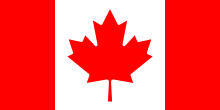
As the Second World War drew to a close, the Royal Canadian Navy (RCN) stopped its rapid expansion and dramatically reduced military expenditures. This resulted in a significant reduction in personnel and ships by 1947. With the emergence of the Cold War and the formation of the North Atlantic Treaty Organization, followed by the outbreak of the Korean War, the Canadian government increased military spending. The RCN recommissioned and modified Second World War ships held in reserve, launched new classes of ships, and upgraded its aviation capabilities. The List of Royal Canadian Navy ships of the Cold War lists the surface warships, submarines and auxiliary vessels in service from the Korean War through to 1991. It includes all commissioned, non-commissioned, loaned or hired ships. and all ships crewed by RCN personnel under the command of the RCN. [1] [2] [3]
Contents
- Surface vessels
- Aircraft carriers
- Light cruisers
- Destroyers
- Destroyer escorts
- Frigates
- Minesweepers
- Patrol vessels
- Submarines
- Auxiliaries
- Auxiliary minesweeping
- Diving support ship
- Escort maintenance ships
- Fireboats
- Gate vessels
- High Speed Launch vessels
- Hydrofoil prototype
- Icebreaker
- Replenishment ships
- Research vessel
- Survey ships
- Training vessels
- Tugboats
- Utility and other boats
- Yard diving tenders
- Submarine non-operational
- See also
- References
- Notes
- Citations
- Bibliography and further reading